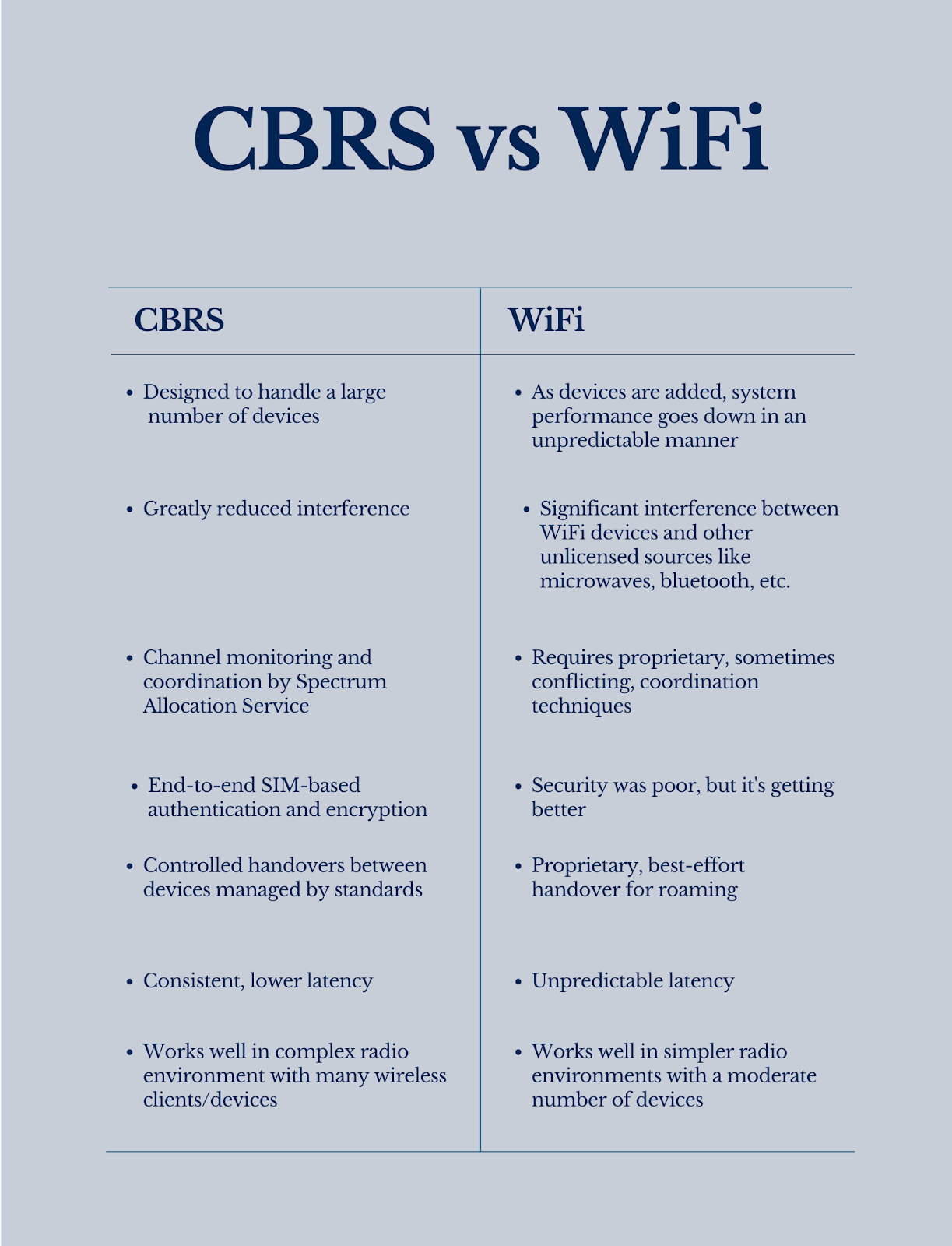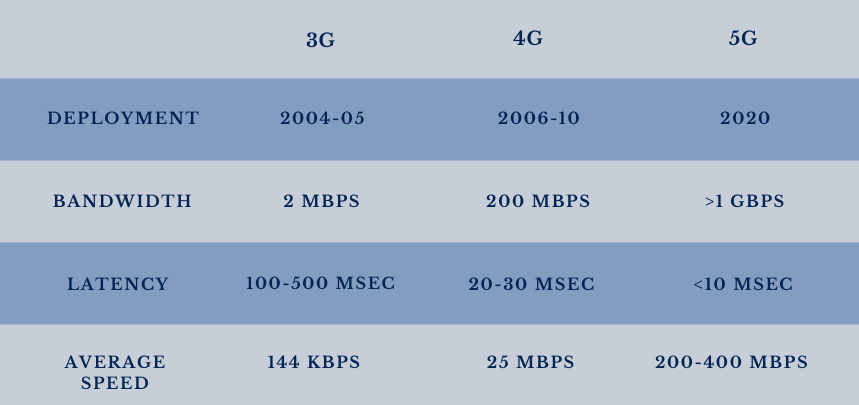In recent times, there has been a great deal of interest in 5G with the upcoming launch of various smartphones and global network upgrades. A less talked about revolution is, however, taking place in enterprise wireless. Citizens Broadband Radio Service (CBRS), a wireless “innovation band” recently made available by the FCC, is aimed at enabling enterprises to operate their own private networks. No longer dependent on the large telecom operators, enterprises can expand their wireless capabilities to unleash innovation. In this article, we explore the capabilities of CBRS, its place in the market, and environments where it is more applicable than WiFi.
The three necessities of life — air, water, and shelter — have now added a fourth . Internet access, especially wireless (WiFi) has become a critical necessity. The pandemic has made this even more clear.
WiFi was invented and first released for consumers in 1997 when IEEE formed a committee called 802.11. This committee defined a set of standards for communication for wireless local area networks (WLANs). WiFi was introduced for home use in 1999. WiFi use in homes grew rapidly as laptop computers became popular.
As the convenience of wireless networking became apparent in the home, employees demanded it at work. They brought in WiFi access points into enterprises to use them. Early WiFi equipment had poor security and hence, CIOs had to ban their use.
However, employees used to hide them in offices. Clearly, IT departments needed an enterprise-class solution. Then Intel started shipping Centrino in every laptop chipset which allowed for WiFi-capability and started the enterprise WiFi revolution.
In the last two decades, WiFi has become ubiquitous in enterprises, public venues, and homes. With each generation, it has become faster and more secure providing functionality in handsets, laptops, cars, home appliances, and even toys. However, WiFi has limitations. The table below lists some of the advantages and disadvantages of WiFi technology.

WiFi does not meet the needs of various mission-critical applications. That is where Enterprise 5G comes in. For the first time, enterprises can set up and operate their own private networks with 5G (and LTE) technologies. Enterprise 5G addresses many of the limitations of WiFi.
What Is CBRS?
CBRS refers to a 3550–3700 MHz band that the FCC has made commercial for enterprises to help alleviate the spectrum crunch. The industry has chosen LTE and 4G/5G technologies to operate in this band. OnGo is the commercial name of LTE/4G/5G networks running on CBRS spectrum, just like WiFi is the commercial name for 802.11 networks standardized by the IEEE. Until recently, this spectrum was allocated to the U.S. Department of Defense and was widely used by the Navy. They can continue to use a portion of this spectrum in coastal areas of the US with preferential access over other users.
In contrast to Enterprise 5G with CBRS, US wireless carriers like AT&T, Verizon, and T-Mobile will deploy 5G networks in higher frequency (24–40 GHz) bands called mmWave bands in densely populated urban areas and lower frequency (sub-6Ghz) bands in rural or suburban areas. However, enterprises will deploy CBRS networks in a lower frequency (3550–3700 MHz) band. While some carriers may consider deploying CBRS networks in suburban areas, most will deploy in the licensed spectrum available only to the carriers.
With the FCC making the CBRS spectrum commercially available, enterprises will be able to install their own private CBRS “cellular” networks for the first time. Giant companies like Google, Apple, Facebook, and others could potentially turn into non-traditional carriers on the CBRS band. Network technology leaders, including incumbents like Cisco, Ericsson, Intel, Motorola, Nokia, and new innovative companies like Celona and Ruckus, are racing to develop CBRS products for enterprises.
An enterprise revolution is around the corner. It is likely that enterprises will deploy their own indoor and/or outdoor private LTE/5G networks over CBRS, creating a large-coverage and high-bandwidth wireless connectivity infrastructure for applications. With the proliferation of wireless and IoT devices, the amount of network traffic continues to increase exponentially. The right analogy would be traffic congestion on highways. However, there are a finite number of available licensed frequencies on the radio spectrum (limited traffic lanes), and those frequencies are being used up rapidly. As a result, the WiFi spectrum has become extremely congested. 5G CBRS helps alleviate this crunch, making a new band of frequencies available and augmenting existing WiFi and licensed spectrum. It creates more “traffic lanes,” reducing congestion.
WiFi is everywhere and widely deployed across large and small enterprises. Most experts believe that WiFi and CBRS will co-exist, as they offer distinct and complementary advantages. So how will CBRS be deployed next to WiFi? Let us first compare CBRS and WiFi.

Key advantages of CBRS based networks
Better indoor and outdoor signal
A private LTE or 5G network on the CBRS band can be used to complement an existing WiFi network or as an alternative to WiFi as the singular wireless connectivity solution. Networks built on CBRS can cover existing cellular coverage gaps in large facilities such as commercial office parks, skyscrapers, manufacturing plants, hotels, and hospitals. Based on the power and propagation of currently available 5G CBRS network access points, users can get up to four times the typical WiFi access point coverage for indoor deployments and more than ten times for outdoor deployments. Compared to existing WiFi systems, network capacity increases significantly due to roughly twice the spectral efficiency. This means that fewer nodes are necessary to provide on-site coverage, making CBRS particularly suitable for venues such as airport runways, seaports, railyards, factories, and chemical refineries where it is much harder, and more expensive, to install cables. CBRS networks can be easily densified to increase network capacity without any degradation in predictability or complications in channel planning.
Improved network security
While WiFi security has significantly improved over the last two decades, it still has wide use of pre-shared keys and other means of insecure options for connectivity. CBRS systems have restricted access based on SIM cards (physical or electronic) and have configurable network topologies so IT can use best practices in cybersecurity design.
Availability of wireless devices
One of the most significant barriers to CBRS rollout is the availability of mobile devices that are compatible with the current spectrum. Just like WiFi’s rapid expansion when Intel announced the Centrino WiFi capability in every laptop chipset by default, device support for 5G CBRS is expected to catalyze market expansion. As of right now, the ever growing number of mobile devices supporting this band includes: new generations of all iPads, iPhone 11 (all models), the latest iPhone SE, Google Pixel 3 (all models), Google Pixel 4 (all models), Lenovo laptops, LG phones (all latest models), and the latest Samsung Galaxy phones.
Beyond these devices, many commercial IoT gateways, bridges, and dongles support this band enabling connectivity to many end devices such as video cameras with Ethernet ports. It is expected that most upcoming 5G devices will support CBRS since it is a part of a common global 5G band supported by most cellular chipsets.
While both 4G/LTE and 5G technologies can be deployed in the CBRS band, 5G offers many new advantages. The table below outlines some of these advantages.

5G CBRS: A world of new possibilities!
Both licensed mm-wave 5G and 5G CBRS will enable a vast number of applications. When 2G and 3G wireless gave way to 4G, it not only increased the performance of the network, but enabled applications like Uber, Doordash, Netflix Anywhere, and Waze. So, what will 5G and 5G CBRS help enable?
4G networks have a 20–30 millisecond latency, the amount of time for a round-trip from request to response. WiFi networks have variable latency depending on channel interference. 5G CBRS is set to reduce latency to single digit milliseconds. Both 5G CBRS and its licensed mm-Wave 5G technology will increase real-time cooperation across the globe. Imagine that technicians with specialized skill sets can control machinery from everywhere in the world, reducing risk in hazardous environments. Production lines can be almost completely automated, and since everything can talk to everything in real-time with cable-like reliability, efficiency will increase dramatically.
The Internet of Things has yet to fulfill its potential. 5G is poised to facilitate the connection of everything requiring a low latency internet connection, from home devices to self-driving cars, paving the way for an environment in which every device is “smart” and connected.
At Cervin Ventures, we are excited about the wide range of capabilities and applications that 5G will enable. Celona, a Cervin portfolio company, is a leader in the Enterprise 5G space enabling AI and edge-compute powered apps in the enterprise.






